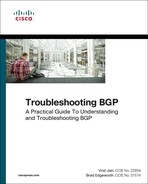Contents
Route Filtering and Manipulation
Peering via Loopback Addresses
Loop Prevention in Route Reflectors
Route Aggregation with Selective Advertisement of AS-SET
Default Route Advertisement per Neighbor
Part II Common BGP Troubleshooting
Chapter 2 Generic Troubleshooting Methodologies
Platform-Specific Packet Capture Tools
Chapter 3 Troubleshooting Peering Issues
Find the Location and Direction of Packet Loss
Verify Whether Packets Are Being Transmitted
Use Access Control Lists to Verify Whether Packets Are Received
Check ACLs and Firewalls in Path
Demystifying BGP Notifications
Troubleshoot Blocked Process in IOS XR
Verify BGP and BPM Process State
Case Study—Single Session Versus Multisession
High CPU Causing Control-Plane Flaps
Local Packet Transport Services
Dynamic BGP Peer Configuration
Resource Issues in a Scaled Environment
Chapter 4 Troubleshooting Route Advertisement and BGP Policies
Troubleshooting BGP Route Advertisement
Local Route Advertisement Issues
Troubleshooting Missing BGP Routes
BGP Communities: Local-AS (No Export SubConfed)
Mandatory EBGP Route Policy for IOS XR
Filtering of Prefixes by Route Policy
Looking Glass and Route Servers
Conditionally Matching BGP Communities
Troubleshooting BGP Router Policies
Incomplete Configuration of Routing Policies
Chapter 5 Troubleshooting BGP Convergence
Understanding BGP Route Convergence
Troubleshooting Convergence Issues
Jumbo MTU for Faster Convergence
Slow Convergence due to Periodic BGP Scan
Slow Convergence due to Default Route in RIB
Slow Convergence due to Advertisement Interval
Computing and Installing New Path
Troubleshooting BGP Convergence on IOS XR
Verifying Convergence During Initial Bring Up
Verifying BGP Reconvergence in Steady State Network
Troubleshooting BGP Convergence on NX-OS
High CPU due to BGP Router Process
Traffic Black Hole and Missing Prefixes in BGP table
Verifying Cache Size and Pending Replication Messages
Troubleshooting BGP Route Flapping
Part III BGP Scalability Issues
Chapter 6 Troubleshooting Platform Issues Due to BGP
Troubleshooting High CPU Utilization due to BGP
Troubleshooting High CPU due to BGP on Cisco IOS
High CPU due to BGP Scanner Process
High CPU due to BGP Router Process
High CPU Utilization due to BGP I/O Process
Troubleshooting High CPU due to BGP on IOS XR
Troubleshooting High CPU due to BGP on NX-OS
Troubleshooting Sporadic High CPU Condition
Troubleshooting Memory Issues due to BGP
Troubleshooting Memory Issues on Cisco IOS Software
Troubleshooting Memory Issues on IOS XR
Troubleshooting Memory Issues on NX-OS
The Impact of Growing Internet Routing Tables
Scaling Internet Table on Various Cisco Platforms
Managing the Internet Routing Table
BGP Peer Templates on Cisco IOS
Soft Reconfiguration Inbound Versus Route Refresh
Enhanced Route Refresh Capability
Outbound Route Filtering (ORF)
Scaling BGP with Route Reflectors
Chapter 8 Troubleshooting BGP Edge Architectures
Resiliency in Service Providers
EBGP and IBGP Multipath Configuration
Understanding BGP Path Selection
Routing Path Selection Longest Match
Locally Originated via Network or Aggregate Advertisement
Accumulated Interior Gateway Protocol (AIGP)
Multi-Exit Discriminator (MED)
Phase I—Initial BGP Edge Route Processing
Phase II—BGP Edge Evaluation of Multiple Paths
Phase III—Final BGP Processing State
Path Selection for the Routing Table
Common Issues with BGP Multihoming
Secondary Verification Methods of a Routing Loop
Problems with Redistributing BGP into an IGP
IPv6 BGP Peering Using Link-Local Address
Protecting BGP Traffic Using IPsec
Route Origination Authorization (ROA)
RPKI Prefix Validation Process
Configuring and Verifying RPKI
BGP Remote Triggered Black-Hole Filtering
Chapter 10 MPLS Layer 3 VPN (L3VPN)
MPLS Layer 3 VPN (L3VPN) Overview
Virtual Routing and Forwarding
Network Advertisement Between PE and CE Routers
MPLS Layer 3 VPN Configuration
Verification of VRF Settings and Connectivity
Viewing VRF Settings and Interface IP Addresses
VRF Connectivity Testing Tools
BGP Configuration for VPNv4 and PE-CE Prefixes
IOS BGP Configuration for MPLS L3VPN
IOS XR BGP Configuration for MPLS L3VPN
NX-OS BGP Configuration for MPLS L3VPN
Verification of BGP Sessions and Routes
Default Route Advertisement Between PE-CE Routers
Suboptimal Routing with VPNv4 Route Reflectors
Troubleshooting Problems with Route Targets
Chapter 11 BGP for MPLS L2VPN Services
Configuration and Verification
Chapter 12 IPv6 BGP for Service Providers
IPv6 BGP Features and Concepts
IPv6 Reachability over IPv4 Transport
IPv4 Routes over IPv6 Next-Hop
IPv6 Provider Edge Routers (6PE) over MPLS
6PE Verification and Troubleshooting
6VPE Control-Plane Verification
VxLAN Flood-and-Learn Mechanism
Configuration and Verification
Integrated Route/Bridge (IRB) Modes
Configuring and Verifying VxLAN BGP EVPN
Chapter 14 BGP High Availability
Bidirectional Forwarding Detection
Asynchronous Mode with Echo Function
Configuration and Verification
BGP FRR and Prefix-Independent Convergence
Scenario 1—IP PE-CE Link/Node Protection on CE Side
Scenario 2—IP MPLS PE-CE Link/Node Protection for Primary/Backup
Chapter 15 Enhancements in BGP
Link-State Distribution Using BGP
BGP Link-State Session Initiation
Provider Backbone Bridging: Ethernet VPN (PBB-EVPN)
